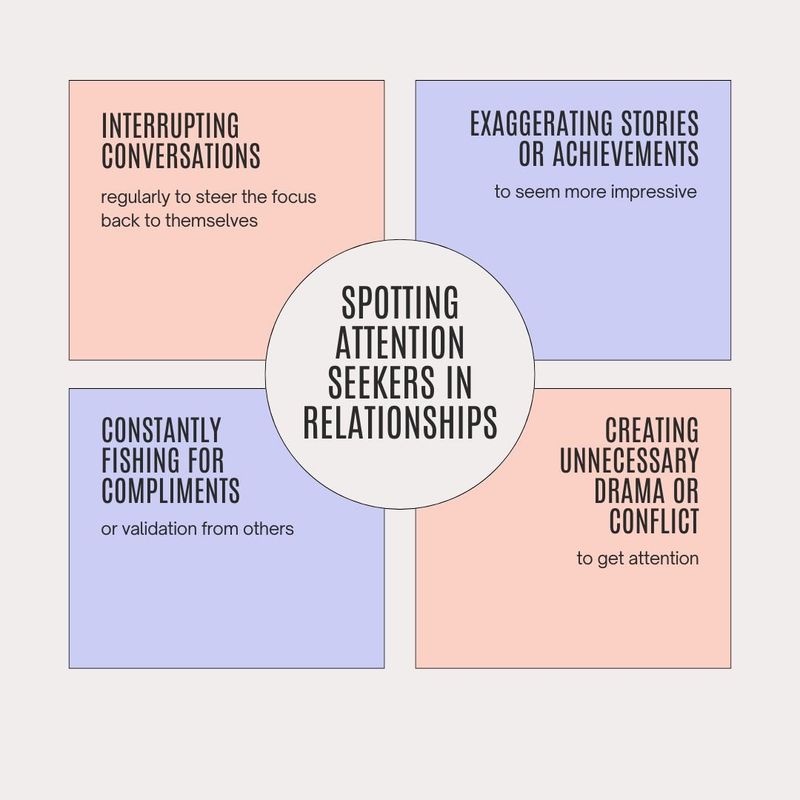Navigating social environments can sometimes leave us questioning the intentions of those around us. While both attention seekers and true extroverts thrive in social settings, their motivations and behaviors differ significantly. Recognizing these differences can help in understanding how individuals engage with their surroundings. True extroverts are driven by an intrinsic desire to connect with others, whereas attention seekers often seek external validation. This article delves into six distinct differences, helping readers identify and appreciate the unique qualities of each personality type. Understanding these traits fosters better relationships and enhances our social experiences.
1. Motivation for Social Interaction

In a lively gathering, what drives people to interact? For attention seekers, it’s often the applause and recognition that fuels their spirit. The chance to shine in the spotlight and receive admiration is irresistible. Alternatively, true extroverts are drawn to the simple joy of connecting with others. Their energy comes from meaningful conversations and shared experiences. Intrinsic motivation guides them, not the need for approval. While attention seekers thrive on validation, true extroverts revel in the vibrancy of human connection. This fundamental difference shapes their social experiences and interactions.
2. Authenticity of Behavior

Picture a group of friends sharing a laugh. Among them, attention seekers might exaggerate their reactions, aiming to capture the spotlight. Their gestures and words are sometimes tailored to impress, lacking sincerity. In contrast, true extroverts are genuine in their enthusiasm. Their interactions are open and sincere, and they’re unafraid to show vulnerability. This authenticity draws others in, creating bonds that are based on trust and genuine emotion. While attention seekers might focus on appearances, true extroverts prioritize meaningful connections through real, heartfelt exchanges.
3. Response to Social Feedback

Imagine two people at a party receiving feedback. Attention seekers are like chameleons, quickly adapting their behavior to match the audience’s reactions. Their sense of self can waver, heavily tied to the opinions of others. Conversely, true extroverts remain consistently themselves, valuing feedback but not letting it dictate their actions. They engage with confidence, maintaining their own identity irrespective of the social winds. This stability allows them to form deeper, more resilient connections. The difference in handling feedback reflects their core motivations, either seeking validation or fostering genuine relationships.
4. Consistency of Social Engagement

In the realm of social gatherings, predictability can be telling. Attention seekers may appear and disappear based on the attention they receive. Their presence is often conditional, depending on the spotlight. True extroverts, however, consistently seek the company of others, finding fulfillment in the mere act of engaging. Their energy isn’t contingent on being the center of attention but on the interactions themselves. This reliability in social settings highlights their genuine love for companionship and conversation, as opposed to the sometimes transient nature of attention seekers’ engagements.
5. Emotional Stability
Consider the emotional landscape in social settings. Attention seekers often experience fluctuating moods, heavily influenced by external validation. Their emotional peaks and troughs are tied to the attention they receive. True extroverts, on the other hand, exhibit a stable emotional demeanor. Their self-esteem isn’t solely reliant on others’ approval but is bolstered by positive interactions. This steadiness provides a secure foundation for their social endeavors. While attention seekers might ride the emotional rollercoaster, true extroverts maintain a balanced, consistent presence, enriching their social circles with stability.
6. Impact on Social Relationships

The impact of one’s social approach can ripple through relationships. Attention seekers often prioritize their need for recognition, sometimes at the expense of depth in relationships. Their connections might be wide but shallow, driven by the quest for admiration. In contrast, true extroverts focus on nurturing deep, meaningful bonds. They invest time and energy into relationships, valuing mutual support and understanding. This depth of connection enhances their social network, creating lasting friendships. The difference lies in the quality over quantity approach, where true extroverts favor enriching, genuine interactions.

